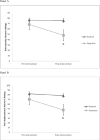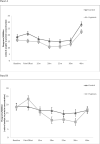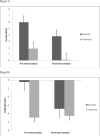Experimental pain ratings and reactivity of cortisol and soluble tumor necrosis factor-α receptor II following a trial of hypnosis: results of a randomized controlled pilot study
- PMID: 22233394
- PMCID: PMC3257832
- DOI: 10.1111/j.1526-4637.2011.01293.x
Experimental pain ratings and reactivity of cortisol and soluble tumor necrosis factor-α receptor II following a trial of hypnosis: results of a randomized controlled pilot study
Abstract
Objective: Current evidence supports the efficacy of hypnosis for reducing the pain associated with experimental stimulation and various acute and chronic conditions; however, the mechanisms explaining how hypnosis exerts its effects remain less clear. The hypothalamic-pituitary-adrenal (HPA) axis and pro-inflammatory cytokines represent potential targets for investigation given their purported roles in the perpetuation of painful conditions; yet, no clinical trials have thus far examined the influence of hypnosis on these mechanisms.
Design: Healthy participants, highly susceptible to the effects of hypnosis, were randomized to either a hypnosis intervention or a no-intervention control. Using a cold pressor task, assessments of pain intensity and pain unpleasantness were collected prior to the intervention (Pre) and following the intervention (Post) along with pain-provoked changes in salivary cortisol and the soluble tumor necrosis factor-α receptor II (sTNFαRII).
Results: Compared with the no-intervention control, data analyses revealed that hypnosis significantly reduced pain intensity and pain unpleasantness. Hypnosis was not significantly associated with suppression of cortisol or sTNFαRII reactivity to acute pain from Pre to Post; however, the effect sizes for these associations were medium-sized.
Conclusions: Overall, the findings from this randomized controlled pilot study support the importance of a future large-scale study on the effects of hypnosis for modulating pain-related changes of the HPA axis and pro-inflammatory cytokines.
Wiley Periodicals, Inc.
Figures





References
-
- Montgomery GH, David D, Winkel G, Silverstein JH, Bovbjerg DH. The effectiveness of adjunctive hypnosis with surgical patients: a meta-analysis. Anesth Analg. 2002;94:1639–45. PubMed: 12032044. - PubMed
-
- Montgomery GH, DuHamel KN, Redd WH. A meta-analysis of hypnotically induced analgesia: how effective is hypnosis? Int J Clin Exp Hypn. 2000;48:138–153. PubMed: 10769981. - PubMed
-
- Schulz-Stubner S, Krings T, Meister IG, Rex S, Thron A, Roissaint R. Clinical hypnosis modulates functional magnetic resonance imaging signal intensities and pain perception in a thermal stimulation paradigm. Reg Anesth Pain Med. 2004;29(6):549–556. PubMed: 15635514. - PubMed
-
- Berger MM, Davadant M, Marin C, Wasserfallen CP, Maravic P, Koch N, Raffoul W, Chiolero RL. Impact of a pain protocol including hypnosis in major burns. Burns. 2010;36:639–646. PubMed: 19880257. - PubMed
-
- Wiechman Askay S, Patterson DR, Jensen MP, Sharar SR. A randomized controlled trial of hypnosis for burn wound care. Rehab Psych. 2007;52(3):247–253.
Publication types
MeSH terms
Substances
Grants and funding
LinkOut - more resources
Full Text Sources
Medical

